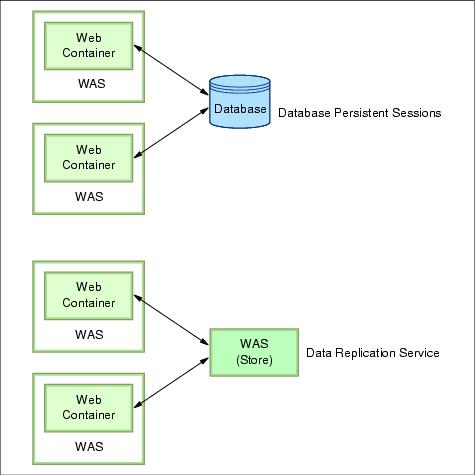Persistent session management
By default, WebSphere places session objects in memory. However, the administrator has the option of enabling persistent session management, which instructs WebSphere to place session objects in a persistent store. Administrators should enable persistent session management when:
- The user's session data must be recovered by another cluster member after a cluster member in a cluster fails or is shut down.
- The user's session data is too valuable to lose through unexpected failure at the WebSphere node.
- The administrator desires better control of the session cache memory footprint. By sending cache overflow to a persistent session store, the administrator controls the number of sessions allowed in memory at any given time.
There are two ways to configure session persistence in WAS V6...
- Database persistence
- Memory-to-memory session state replication using the data replication service available in distributed server environments

All information stored in a persistent session store must be serialized. As a result, all of the objects held by a session must implement java.io.Serializable if the session needs to be stored in a persistent session store.
In general, consider making all objects held by a session serialized, even if immediate plans do not call for the use of persistent session management. If the Web site grows, and persistent session management becomes necessary, the transition between local and persistent management occurs transparently to the application if the sessions only hold serialized objects. If not, a switch to persistent session management requires coding changes to make the session contents serialized.
Persistent session management does not impact the session API, and Web applications require no API changes to support persistent session management. However, as mentioned previously, applications storing unserializable objects in their sessions require modification before switching to persistent session management.
If you use database persistence, using multi-row sessions becomes important if the size of the session object exceeds the size for a row, as permitted by the WebSphere session manager. If the administrator requests multi-row session support, the WebSphere session manager breaks the session data across multiple rows as needed. This allows WebSphere to support large session objects. Also, this provides a more efficient mechanism for storing and retrieving session contents under certain circumstances.
Using a cache lets the session manager maintain a cache of most recently used sessions in memory. Retrieving a user session from the cache eliminates a more expensive retrieval from the persistent store. The session manager uses a least recently used scheme for removing objects from the cache. Session data is stored to the persistent store based on your selections for write frequency and write option.